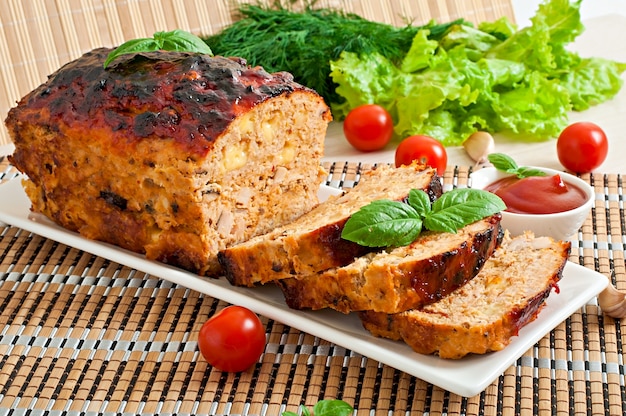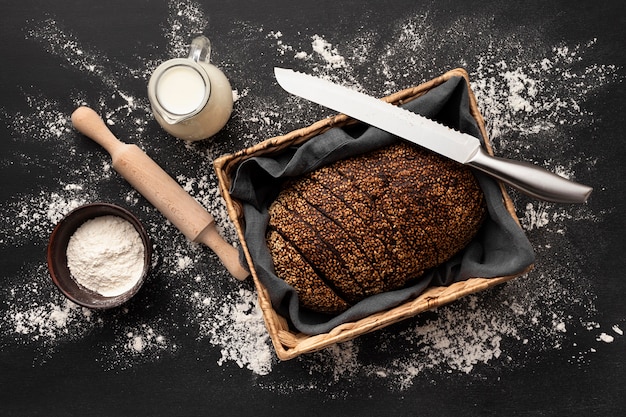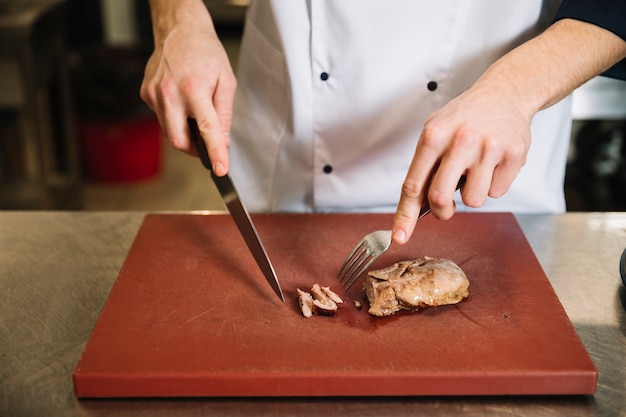Oh, the meatloaf! This humble dish, a staple in kitchens across the globe, holds a special place in my heart. It's more than just a meal; it’s a culinary journey, a testament to patience and creativity, and a celebration of good, honest cooking. But let's be honest, the question that always pops up is: how long do you bake it at 400 degrees Fahrenheit?
I’ve been baking meatloaf for years, and I’ve learned that there's no magic formula. It's a constant dance between temperature, time, and intuition. This article is about sharing that journey, the triumphs and the occasional flops, the tips and tricks I've discovered along the way. From mastering the perfect bake to crafting irresistible flavour combinations, we'll dive deep into the heart of this culinary classic. So, grab a fork and a comfy chair – it’s going to be a tasty adventure.
Part 1: The Meatloaf Conundrum: Baking Time and Temperature

The first hurdle, the one that always seems to throw us off guard, is the question of baking time. We long for a simple answer, a magic number that guarantees a perfectly cooked meatloaf every time. But alas, it's not that straightforward. Baking time hinges on a multitude of factors, like the size of your loaf, the type of meat you’re using, and the quirks of your oven. It's a delicate dance, and you need to learn the rhythm.
1.1 The Size Factor: From Mini to Mammoth
Imagine a miniature meatloaf, just big enough for one. It’s a quick bake, probably 30-40 minutes at 400 degrees Fahrenheit. Now, picture a family-sized masterpiece, bursting with flavour and enough to feed a hungry crowd. That's where things change. Those larger loaves need more time in the oven, closer to 60-75 minutes to cook through. So, size matters, my friends. It’s a fundamental truth in the meatloaf world.
1.2 The Meat Factor: Lean vs. Fat, Fast vs. Slow
The type of meat you choose plays a crucial role in baking time. Lean ground beef, like the 90/10 variety, cooks faster than ground pork or ground turkey. Why? The fat content. Leaner meat has less fat, which translates to a quicker cooking time. If you're using a mixture of meats, like a classic blend of ground beef, pork, and veal, be mindful of the fat content. You might find yourself adjusting the baking time to accommodate the different cooking rates.
1.3 The Oven Factor: The Unpredictable Wild Card
Even if you stick to the same recipe, different ovens can be real wild cards. Some ovens are hotheads, running at a higher temperature than indicated. Others are more subdued, running cooler. These variations can dramatically affect the baking time. And to add another layer of complexity, even within the same oven, the top and bottom racks might behave differently. It's like a constant game of oven roulette! That’s why a little experimentation is often necessary to find the sweet spot for your specific oven.
Part 2: The Art of the Meatloaf: A Deeper Dive

We've tackled the basics of baking time, but crafting a truly remarkable meatloaf is about more than just cooking it right. It's about creating a masterpiece, a symphony of flavours and textures.
2.1 The Meat Mixture: Building a Solid Foundation
A delectable meatloaf begins with a well-balanced meat mixture. I'm a big fan of combining ground beef, ground pork, and a touch of veal for added richness. Using high-quality meat is crucial, because it's the foundation of the flavour. Don't be afraid to experiment! There's a whole world of meat combinations out there, waiting to be explored. Just remember, the flavour of the meatloaf is directly influenced by the quality of the ingredients.
2.2 The Secret Ingredient: The Binder
To prevent your meatloaf from turning into a crumbly mess, you need a binder. Bread crumbs, oats, crushed crackers – these are the unsung heroes of meatloaf, holding everything together. My go-to is a mixture of bread crumbs and oats. They create a delightful moistness and a hint of crispy texture that complements the meat perfectly. The binder adds structure, preventing the meatloaf from falling apart and giving it a satisfying texture when you take that first bite.
2.3 The Flavour Explosion: spices and herbs
Now, this is where things get exciting! The world of spices and herbs opens up endless possibilities for flavouring your meatloaf. My go-to is a combination of onions, garlic, Worcestershire sauce, paprika, and black pepper. It's a classic blend, providing a robust and savoury flavour. But don’t hesitate to experiment. Cumin, thyme, rosemary – these can add layers of complexity and depth to your meatloaf. And remember, a pinch of salt brings out the best in all the other flavours.
2.4 The Final Touch: The Glaze
Think of the glaze as the finishing touch, the cherry on top of your meatloaf sundae. A delicious glaze can transform a simple meatloaf into a culinary masterpiece. My personal favourite is a mixture of ketchup, brown sugar, and mustard. The sweet and tangy glaze complements the savoury meatloaf beautifully, creating a harmonious blend of flavours. But there's a whole world of glazes out there, waiting to be discovered. Balsamic glaze, honey-soy glaze – experiment, explore, and find the glaze that speaks to your palate.
Part 3: Baking Time: The Key to Success

We've covered the ingredients, the flavour profiles, now it's time to talk about the baking process. This is where the magic happens, and where careful attention is key to ensure that your meatloaf is cooked through and perfectly browned.
3.1 The Oven Temperature: Setting the Stage
The standard oven temperature for meatloaf is 400 degrees Fahrenheit (200 degrees Celsius). This high heat ensures quick and even cooking without drying out the meat. But remember, every oven has its own personality. If yours tends to run hot, consider lowering the temperature to 375 degrees Fahrenheit (190 degrees Celsius) to prevent over-browning.
3.2 The Baking Time: It's a Guesstimate Game
As we've discussed, there's no one-size-fits-all answer for baking time. It’s a delicate dance between the size of your meatloaf and the quirks of your oven. A good starting point is 45-60 minutes, but don't be afraid to adjust based on your experience and the specific recipe. The key is to check the internal temperature to ensure it's cooked through.
3.3 The Internal Temperature: The Ultimate Test
This is where a meat thermometer becomes your best friend. It's the ultimate test to determine if your meatloaf is cooked to perfection. The internal temperature should reach at least 160 degrees Fahrenheit (71 degrees Celsius) for safe consumption. If it's not quite there, simply pop it back in the oven for a few more minutes until it reaches the desired temperature. Trust your thermometer, it’s your guide to meatloaf perfection.
3.4 The Browning Test: A Visual Clue
While the internal temperature is the ultimate indicator, you can also rely on visual cues. A perfectly baked meatloaf will have a beautiful, golden-brown exterior. It should be firm to the touch. If the top starts to brown too quickly, cover it loosely with aluminium foil to prevent further browning. It's all about achieving that perfect balance between a crispy crust and a juicy interior.
Part 4: meatloaf variations: Beyond the Basics
Meatloaf doesn't have to be a predictable dish. Let's explore some variations that will add excitement and intrigue to your culinary repertoire.
4.1 The Veggie Lover's Delight: Incorporating Vegetables
For a healthier and more flavourful meatloaf, consider incorporating vegetables into your mixture. Chopped onions, garlic, carrots, or celery add a delightful texture and a burst of sweetness. Experiment with different vegetables, find your favourites, and create a meatloaf that reflects your taste buds. The possibilities are endless.
4.2 The Cheesy Indulgence: Adding a Layer of Creaminess
For a truly decadent meatloaf, indulge in a layer of cheese. Cheddar, mozzarella, crumbled blue cheese – they all add a creamy and salty dimension to the dish. For an extra layer of indulgence, top your meatloaf with a combination of cheeses. Don't be afraid to get creative! And if you’re feeling adventurous, add some chopped bacon or ham for a salty and smoky flavour that will elevate your meatloaf to new heights.
4.3 The Global Twist: Exploring Different Flavour Profiles
Meatloaf is a versatile canvas for exploring different culinary cultures. Embrace a Mexican twist with jalapenos and cumin, or add an Italian flair with sundried tomatoes and oregano. For a touch of Asian inspiration, try incorporating soy sauce, ginger, and sesame oil. The world is your oyster, so let your imagination run wild!
Part 5: meatloaf serving suggestions: A Feast for the Senses
Your meatloaf is baked to perfection, golden brown and bursting with flavour. Now, it's time to celebrate your culinary achievement and enjoy the fruits of your labour. Here are some serving suggestions that will elevate your meatloaf from a simple meal to a feast for the senses.
5.1 The Classic Pairing: mashed potatoes and Gravy
The quintessential pairing: meatloaf, mashed potatoes, and gravy. It's a classic for a reason. The creamy mashed potatoes provide a comforting counterpoint to the savoury meatloaf, while the rich gravy adds an extra layer of flavour and richness. For a complete and balanced meal, add a side of steamed green beans or asparagus. This is a dish that will bring back childhood memories and warm your soul.
5.2 The Seasonal Delight: Roasted Vegetables
For a lighter and more seasonal approach, serve your meatloaf with roasted vegetables. roasted carrots, broccoli, or Brussels sprouts add a touch of sweetness and earthiness to the dish. Drizzle them with olive oil and herbs for an extra burst of flavour. This is a simple yet elegant combination that celebrates the best of the season.
5.3 The Gourmet Touch: A Fancy Salad
Elevate your meatloaf to gourmet status by pairing it with a fancy salad. A mixed green salad with goat cheese, walnuts, and balsamic vinaigrette provides a refreshing and tangy contrast to the richness of the meatloaf. This is a sophisticated and elegant way to enjoy your culinary creation.
Part 6: The meatloaf leftovers: A Culinary Treasure
Let's face it, meatloaf is often made in generous quantities, leaving us with delicious leftovers. But don't despair! Those leftovers are a culinary treasure, just waiting to be transformed into new and exciting dishes.
6.1 The Cold Sandwich Delight: A Classic comfort food
A cold meatloaf sandwich is a classic comfort food that never fails to satisfy. Simply slice the meatloaf, spread it on some bread, and add your favourite toppings, like lettuce, tomato, and mayonnaise. It's a perfect lunchtime treat, a quick snack, or a nostalgic reminder of simpler times.
6.2 The Hearty Soup: A Warm and Satisfying Meal
Transform your leftover meatloaf into a hearty and satisfying soup. Dice the meatloaf and add it to your favourite soup recipe. The leftover gravy can be used to enhance the flavour and richness of the soup. It’s a simple and delicious way to use up your leftovers.
6.3 The Creative Casserole: A Delicious and Versatile Meal
Leftover meatloaf can be the base for a creative casserole. Layer the meatloaf with your favourite vegetables and cheese, and bake until heated through. It's a perfect way to use up leftover meatloaf and create a delicious and filling meal. The possibilities are endless, so get creative and explore your culinary imagination.
Part 7: meatloaf mistakes: Avoiding the Culinary Pitfalls
Even the most experienced cooks can make mistakes. But don't worry, we're here to help you avoid those common meatloaf pitfalls and ensure culinary triumph.
7.1 The Over-Baked Meatloaf: A Dry and Unforgiving Disaster
Over-baking is one of the biggest mistakes you can make with meatloaf. It can lead to a dry and crumbly texture that's far from appealing. To avoid this, rely on your trusty meat thermometer. Ensure that the internal temperature reaches 160 degrees Fahrenheit (71 degrees Celsius). If you're unsure, it's always better to slightly under-bake than to over-bake. A slightly undercooked meatloaf can be reheated, but an overcooked one is beyond redemption.
7.2 The Under-Baked Meatloaf: A Risky Culinary Venture
Under-baking a meatloaf is a food safety hazard, as it can result in undercooked meat. This is where your meat thermometer is your lifeline. Ensure that the internal temperature reaches 160 degrees Fahrenheit (71 degrees Celsius) to ensure that the meat is cooked through and safe for consumption. If you're unsure, it's always better to slightly over-bake than to under-bake. Safety first, my friends.
7.3 The Cracking Meatloaf: A Visual Disappointment
A cracking meatloaf might not affect the taste, but it’s not the most appealing sight. To avoid this, make sure that the mixture isn’t too wet. If it's too wet, add more breadcrumbs or oats. You can also wrap the meatloaf in bacon to prevent cracking. The bacon adds a smoky flavour and a crispy barrier that helps keep the meatloaf intact.
Part 8: FAQs: Addressing Your Meatloaf Questions
We've covered a lot of ground in this culinary adventure, but you might still have some lingering questions. So, here are some frequently asked questions about meatloaf, and hopefully, their answers will help you on your journey to meatloaf perfection.
8.1 How long should I bake a 2-pound meatloaf at 400 degrees Fahrenheit?
A 2-pound meatloaf should bake for approximately 60-75 minutes at 400 degrees Fahrenheit (200 degrees Celsius). However, it's always best to check the internal temperature with a meat thermometer to ensure it's cooked through. Remember, baking times can vary depending on the oven and the specific recipe you’re using.
8.2 Can I bake a meatloaf in a slow cooker?
Absolutely! You can bake a meatloaf in a slow cooker. First, brown the meat mixture in a pan to add a touch of richness and flavour. Then, transfer it to the slow cooker. Cook on low for 6-8 hours or on high for 3-4 hours. The slow cooker method is ideal for those busy weeknights when you need a hassle-free meal.
8.3 What are some good substitutes for breadcrumbs in a meatloaf?
Don't worry if you're out of breadcrumbs. You can use oats, crushed crackers, or finely chopped vegetables like zucchini or carrots as substitutes. Just make sure to use enough binder to keep the meatloaf from falling apart. Experiment with different binders to find what works best for your taste and texture preferences.
8.4 Can I freeze leftover meatloaf?
Yes, you can freeze leftover meatloaf. Simply wrap it tightly in plastic wrap and then aluminum foil. It can be stored in the freezer for up to 3 months. To thaw, simply transfer the meatloaf to the refrigerator overnight. Freezing allows you to enjoy your delicious meatloaf creations even after they’ve been made.
8.5 How do I make a meatloaf with a crispy crust?
To achieve a crispy crust, bake the meatloaf uncovered for the first 30-40 minutes. Then, cover it loosely with aluminum foil for the remaining baking time. This allows the crust to brown and crisp while the inside cooks through. It's the best of both worlds: a crispy exterior and a juicy, flavourful interior.
Remember, baking a meatloaf is a journey, not a race. It's about taking the time to experiment, to explore different flavours and techniques, and to discover your own personal meatloaf magic. So, grab your ingredients, your favourite spices, and your trusty meat thermometer, and embark on your own culinary adventure.
Everyone is watching

Prime Rib Roast Cooking Time Chart: Per Pound Guide
Cooking TipsPrime rib roast. Just the name conjures images of lavish dinners, crackling fires, and hearty laughter. It’s ...

How Long to Bake Potatoes in the Oven (Perfect Every Time)
Cooking TipsBaked potatoes are a staple in my kitchen. They're incredibly versatile, delicious, and surprisingly easy to m...

Perfect Rice Every Time: The Ultimate Guide to Cooking Rice
Cooking TipsAs a self-proclaimed foodie, I've always been a bit obsessed with rice. It's the foundation of countless cuisi...

The Ultimate Guide to Cooking Asparagus: Tips, Techniques, and Recipes
Cooking TipsAsparagus. The mere mention of this spring delicacy conjures up images of vibrant green spears, crisp and burs...

Ultimate Guide to Cooking the Perfect Thanksgiving Turkey
Cooking TipsThanksgiving. Just the word conjures up images of overflowing tables laden with delicious food, the scent of r...
